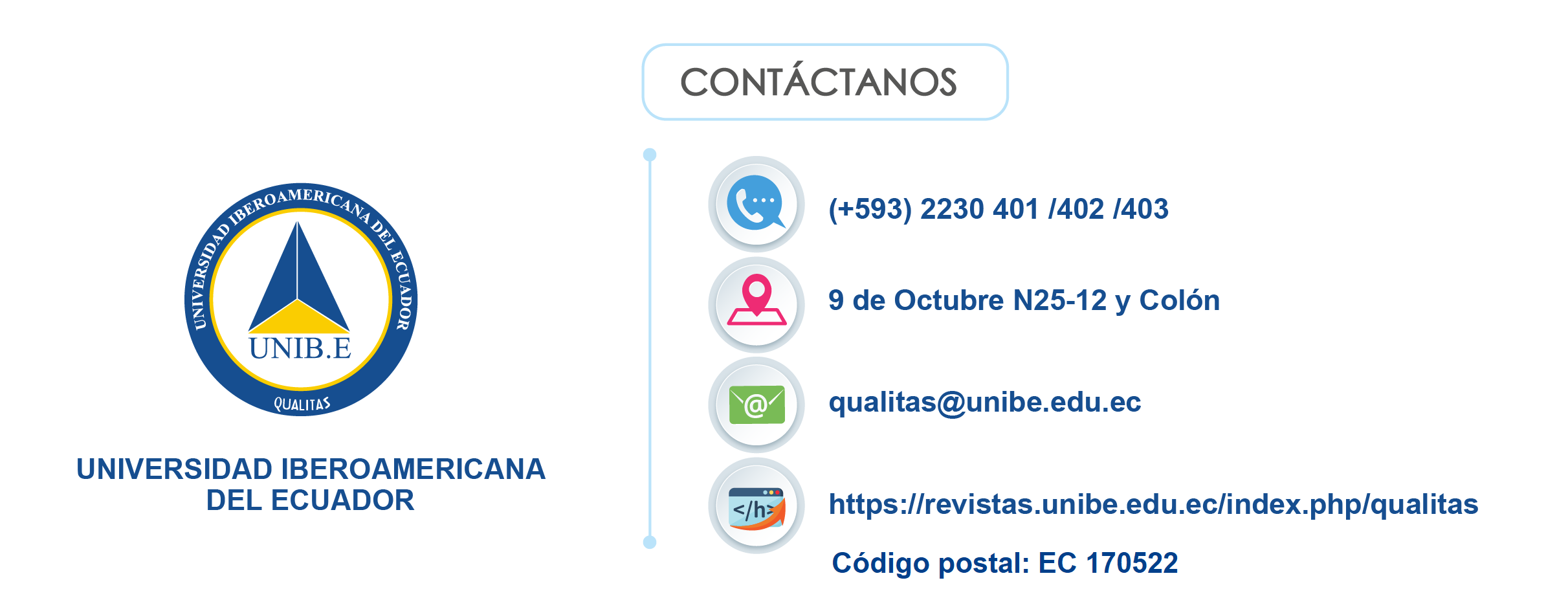Guidelines for the use of teaching strategies that promote significant learning
DOI:
https://doi.org/10.55867/qual28.01Keywords:
guidelines, didactic strategies, meaningful learning, nursingAbstract
The present research has a quantitative, field approach, with a non-experimental design, which aimed to formulate guidelines for the use of Didactic Strategies in the promotion of Significant Learning by Teachers of the UDE Nursing Program. The population was made up of 120 teachers, to whom a structured questionnaire was applied to diagnose the level of knowledge about meaningful learning, teaching strategies that promote it, as well as the use of these in their teaching performance. To analyze the data, descriptive statistics were used through percentages, using the simple frequency distribution and measures of central tendencies required according to the study variables. It was found that 83 (69%) on average of teachers lack knowledge about meaningful learning and the types of teaching strategies that promote it. Likewise, it was evident that the strategy most used by them corresponds to exposure throughout the class. Based on the results, guidelines are formulated concerning the use of Teaching Strategies that promote Meaningful Learning, to offer alternatives to direct, channel, and encourage the achievement of learning in students.
Downloads
References
Abrami, P., Bernard, R., Borokhovski, E., Waddington, D.I., Wade, C.A., & Persson, T. (2015). Strategies for teaching students to think critically: A meta-analysis. Review of Educational Research, 85(2), 275-314. https://knilt.arcc.albany.edu/images/9/9b/Critical_thinking_.pdf
Ausubel, D. P.; Novak, J. D. y Hanesian, H. (1983). Psicología educativa: un punto de vista cognoscitivo. México, Editorial Trillas. Traducción al español, de Mario Sandoval P., de la segunda edición de Educational psychology: a cognitive view.
Asgharheidari, F., & Tahiri, A. (2015). A survey of EFL teachers' attitudes towards critical thinking instruction. Journal of Language Teaching and Research, 6(2), 388-396. http://www.academypublication.com/issues2/jltr/vol06/02/20.pdf
Barrios V, BM & Camacho H, EE (2021). Aprendizaje por descubrimiento aplicado a la multiplicación de números naturales. Revista de Educación WARISATA, Volumen 2 / Nro. 7 / Enero - abril 2021 / ISSN: 2708 - 6305 / ISSN-L: 2708 - 6305 / Pág. 40 – 52. www.revistawarisata.org
Baque-Reyes, G., & Portilla-Faican, G. (2021). El aprendizaje significativo como estrategia didáctica para la enseñanza – aprendizaje. Polo del Conocimiento, 6(5), 75-86. DOI: http://dx.doi.org/10.23857/pc.v6i5.2632
Chen, L. L. (2016). Impacts of Flipped Classroom in High School Health Education. Journal of Educational Technology Systems, 44(4), 411- 420. DOI:10.1177/0047239515626371
Díaz-Barriga, F., y Hernández, G. (2002). Estrategias docentes para un aprendizaje significativo. Una interpretación constructivista. México: McGraw Hill.
Díaz, F. (2014). Las Tic en la educación y los retos que enfrentan los docentes. OEI, Organización de Esta- dos Iberoamericanos. http://www.oei.es/metas2021/expertos02.htm.
Gómez V, LE, Muriel M, LE y Londoño-Vásquez, DA (2019). El papel del docente para el logro de un aprendizaje significativo apoyado en las TIC. Encuentros, vol. 17, núm. 02, pp. 118-131, 2019 - Universidad Autónoma del Caribe. https://www.redalyc.org/journal/4766/476661510011/html/
Guamán Gómez, Verónica Jacqueline, & Venet Muñoz, Regina. (2019). El aprendizaje significativo desde el contexto de la planificación didáctica. Conrado, 15(69), 218-223. Epub 02 de septiembre de 2019. Recuperado en 11 de abril de 2024, de http://scielo.sld.cu/scielo.php?script=sci_arttext&pid=S1990-86442019000400218&lng=es&tlng=es.
Huber, C.R. & Kuncel, N.R. (2016). Does College Teach Critical Thinking? A Meta-Analysis. Review of Educational Research, 86 (2), 431-468. https://psycnet.apa.org/record/2016-23388-004
Latorre, M. (2017). Aprendizaje Significativo y Funcional. Lima / Perú: Universidad Champagnat. https://issuu.com/uchampagnat/docs/64_hml_aprendizaje_significativo_y_
Manrique, María Soledad. (2020). Tipología de procesos cognitivos. Una herramienta para el análisis de situaciones de enseñanza. Educación, 29(57), 163-185. https://dx.doi.org/10.18800/educacion.202002.008
Marín, Leonardo, Suárez, José, González, Yaikel, & Pelegrín, Analien. (2018). La clase encuentro en la educación superior: algunas consideraciones teóricas -metodólogicas. Revista de Ciencias Humanísticas y Sociales (ReHuSo), 3(3), 88-100. Epub 03 de diciembre de 2018. https://doi.org/10.33936/rehuso.v3i3.1505
Montes, A.; Villalobos, V. & Ruiz, W. (2020). Estrategias didácticas empleadas desde la presencialidad remota en la División de Educación para el Trabajo de la Universidad Nacional en tiempos de pandemia. Revista Innovaciones Educativas. vol. 22, núm. Esp.0. http://portal.amelica.org/ameli/journal/428/4281967030/html/
Pamplona-Raigosa, Jennifer; Cuesta-Saldarriaga, Juan Camilo; & Cano-Valderrama, Viviana. (2019). Estrategias de enseñanza del docente en las áreas básicas: una mirada al aprendizaje escolar. Revista eleuthera, 21, 13-33. https://doi.org/10.17151/eleu.2019.21.2
Ramos, H. (2021). Efectividad de los organizadores previos para el aprendizaje significativo de la cinemática. Revista de Investigación Proyección Científica, 3(1), 117-131. https://doi.org/10.56785/ripc.v3i1.64
Tamayo Lopera, Diego Alfredo, Merchán Morales, Vilma, Hernández Calle, Jonathan Andrés, Ramírez Brand, Sandra Milena, & Gallo Restrepo, Nancy Eliana. (2018). Nivel de desarrollo de las funciones ejecutivas en estudiantes adolescentes de los colegios públicos de Envigado-Colombia. CES Psicología, 11 (2), 21-36. https://doi.org/10.21615/cesp.11.2.3
Suarez, E. y Padín, M. (2019). Estrategias pedagógicas para facilitar la comprensión de contenidos contables a través de entornos virtuales en Argentina. REDINE (Ed.) Eindhoven, NL: Adaya Press. https://www.adayapress.com/wp-content/uploads/2019/05/Estrategias.pdf
Suniaga Asunción (2019). Metodologías Activas: Herramientas para el empoderamiento docente. https://www.researchgate.net/publication/362722196_Metodologias_Activas_Herramientas_para_el_empoderamiento_docente
Published
How to Cite
Issue
Section
License
Copyright (c) 2024 Ana Teresa Berrios Rivas, Isabel Cristina Meléndez Mogollón, Esperanza Marbella Palencia Gutiérrez, Elsa Josefina Pezo Ortíz

This work is licensed under a Creative Commons Attribution 4.0 International License.



















